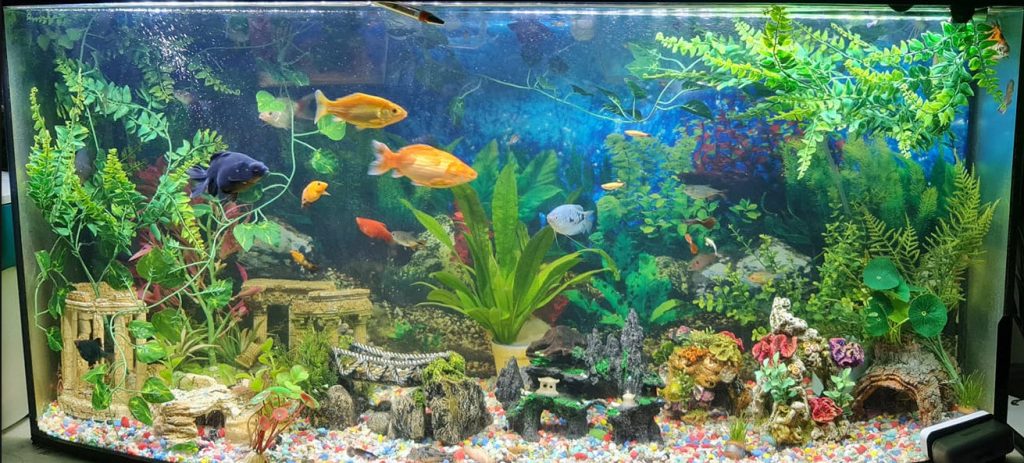
Carbonate Hardness
“Carbonate hardness” or “KH” is a confusing term because it does not refer directly to what most people associate with the term “hardness”. “Hard water” is normally thought of as high GH water which can be so “hard” it creates “hard” deposits in water lines. These “hard” deposits what the term “hardness” is normally associated with. High KH alone will not produce “hard” deposits in a pipe.
The pH, KH and carbon dioxide relationship is the “Bermuda Triangle” of fish keeping: go there and you may never come out. What is important is that KH is just not important in the aquarium. This fact is sufficient for most hobbyists. If one is a real nerd (like the author) and wants to become very confused, read on:
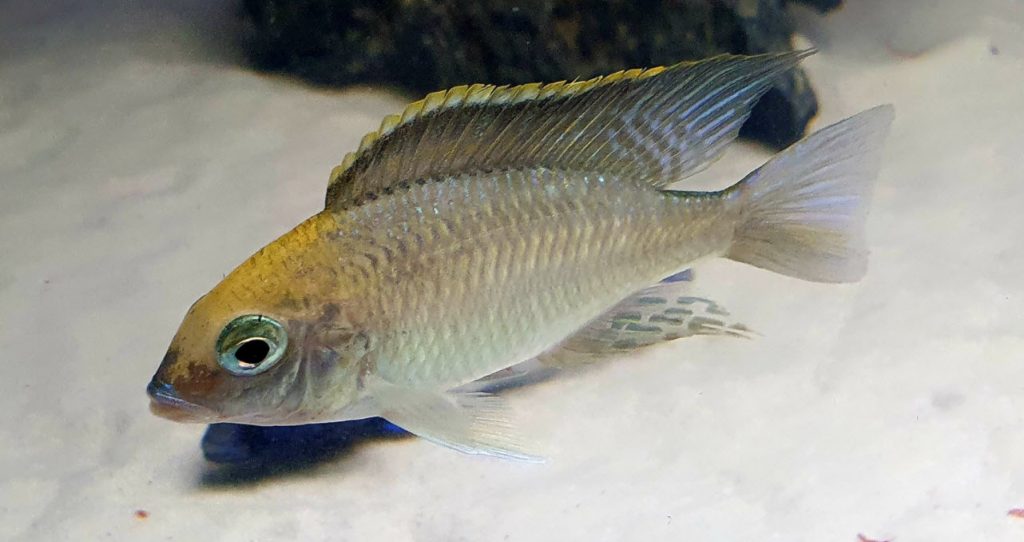
KH refers solely to the buffering alkalinity (the ability of a solution to resist a pH change with an addition of an acid) from the carbonates and bicarbonates in the water. KH refers to only the bicarbonate, and carbonate anions (negatively charged ions); it does not measure the sulfates and other anions. KH comes from the German term “Karbonatharte” or carbonate hardness.
The term “alkalinity” is commonly used to indicate KH. Note that the terms “alkaline” and “alkalinity” refer to different things. “Alkaline” refers to a pH greater than 7 while “alkalinity” refers to the buffering capacity of the water. To confuse matters even more many use the terms “total alkalinity” to refer to the KH when in actuality “total alkalinity” measures both hydroxides and carbonates together.

The Bermuda Triangle of Fish Keeping
CO2, pH and carbonates are supposedly related by the following three equations:
CO2 + H2O = H2CO3 (“Carbonic Acid” at low pH)
H2CO3 = H+ + HCO3– (Bicarbonate at moderate pHs)
H+ + HCO3– = 2H+ + CO3– (Carbonate at higher pHs)
In truth, this isn’t the way it works. Carbonic acid doesn’t exist. The actual chemical species is a water carbon dioxide complex:
CO2 + 4 H2O = CO2:(H2O)4 (Complexed CO2 in water)
And the existence of the carbonate and bicarbonate (i.e. KH) are dependent on certain cations like sodium and calcium to produce a high pH that allows them to exist. This very complex CO2/KH/pH relationship is analyzed in depth in these two articles:
4.4.3. Carbon Dioxide and pH
15.6.2. CO2, KH and pH in a Planted Aquarium
In addition the other anions and the cations in the water all affect this CO2/KH/pH triangle to one degree or another by affecting the pH which in turn affects the KH. Complicating the CO2/KH/pH triangle even more the whole thing is very affected by the temperature of the water. Bicarbonate converts to carbonate at higher temperatures. And the whole thing is affected by the variable of time. Some of the chemical reactions occur in seconds and some take days.
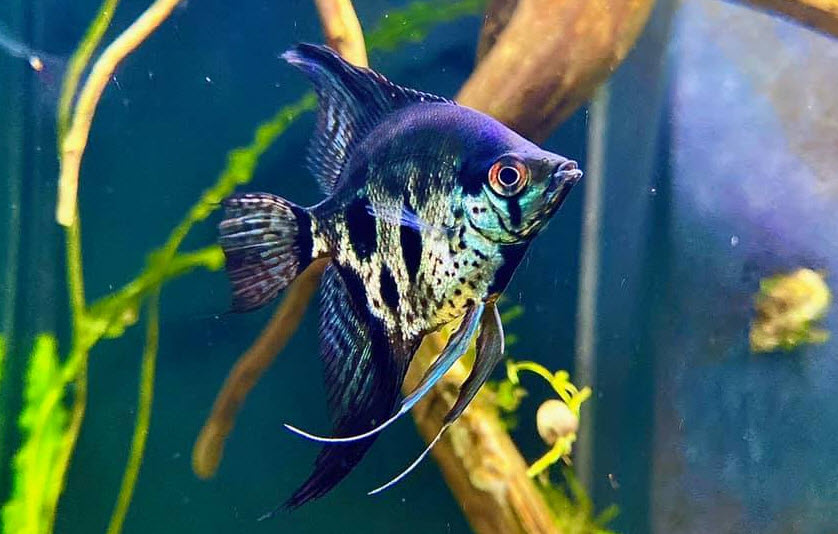
If one has a planted tank, things get even more confusing. All plants and algae take carbon dioxide out of the water and produce oxygen. Some plants and algae take bicarbonate and carbonate out of the water and produce oxygen. So the KH of the water in a well planted, well lit tank CAN possibly fall to close to absolute zero after several hours of being in the light.
But complicating this fact is that carbon dioxide from the atmosphere CAN take the carbonate back. And plants excrete carbon dioxide in the dark. There are no studies on the effect of KH on fish simply because of that high variability. If you measure your KH understand that the KH may well be far different in just a few hours. KH goes up and down constantly in most aquariums. If this all confuses you, join 99.9% of the population.
The author has raised and bred Lake Malawi cichlids, Lake Tanganyikan cichlids, guppies, mollies and platies in the soft acid water of Connecticut. The author has also raised and bred blackwater rams in the hard alkaline waters of Florida. Oscars, a fish native to the very soft, acid, low KH waters of the Rio Negro river (in all fairness some authorities dispute that), have naturalized in the high dKH waters of Florida and are an invasive species there.
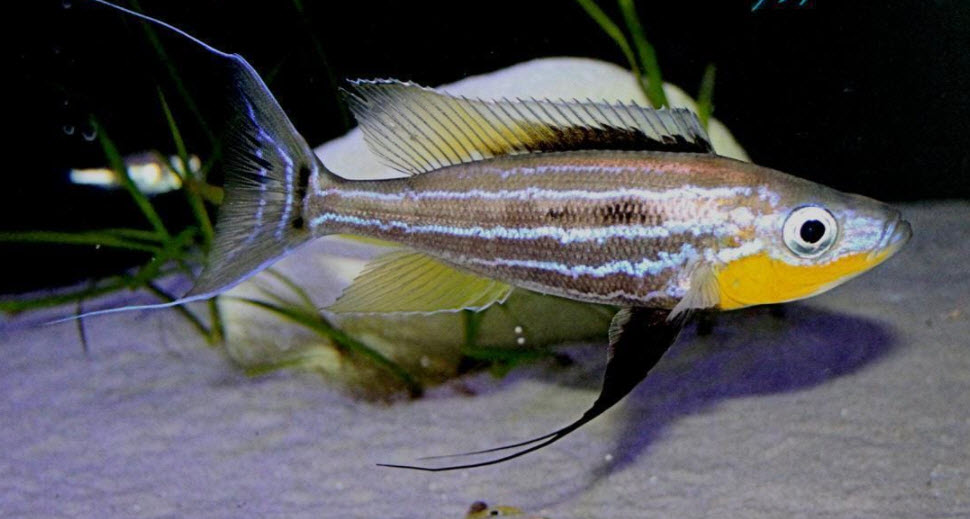
A reading of zero KH is no problem at all. It will not create health problems with the fish. Many like to keep a higher KH in order to prevent a phenomenon called “Old Tank Syndrome”. Old Tank Syndrome is actually rarely seen if you are doing any sort of decent water changes. But adding KH with something like calcium carbonate (crushed coral or aragonite sand) to the aquarium will not hurt anything.
Carbonate is important for cycling. KH or carbonate is consumed by ammonia as it converts to nitrate. This can drop the pH down and stop the beneficial bacteria from working. So one normally has to add baking soda during intensive cycling. Each 10 ppm of ammonia converted to nitrate consumes about 72 KH (4 dKH). Or one gram of most ammonium salts consumes about three grams of sodium bicarbonate. One never wants zero KH during cycling. This will stop the cycling cold.
My tanks all have a bag of crushed coral in the filter at all times. Note that some get concerned with a high KH. A high KH per se is no problem. Also note that most tap water in the USA is high KH (15 to 25 dKH, 300 to 450 KH).
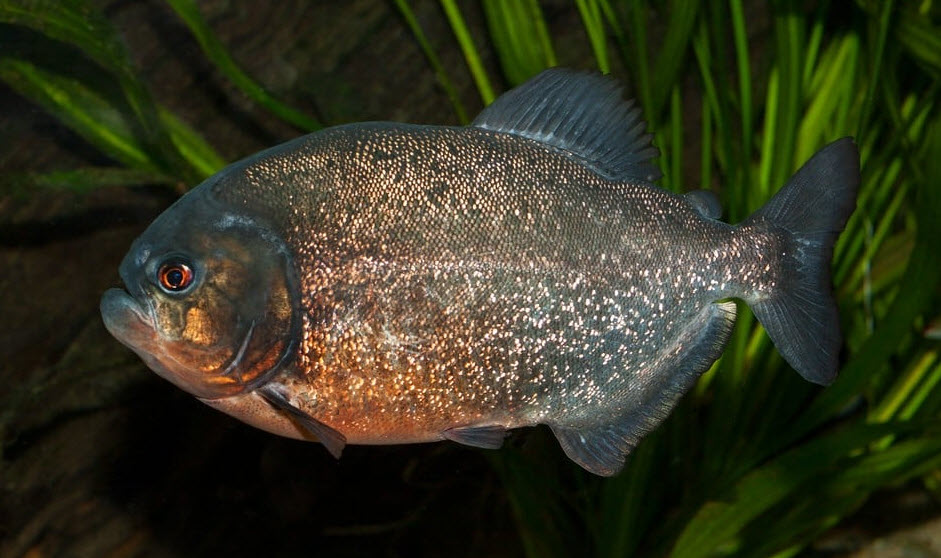
KH and Ammonia
Many say that if the pH swing from a low pH to a high pH the relatively harmless ammonium in the water will be converted to harmful ammonia and the fish will suffer. By this mechanism supposedly KH becomes very important. This is only true in an aquarium with very poor filtration and very high ammonia.
Virtually all the aquarium ammonia tests measure the TOTAL “ammonia”, i.e. ammonium plus ammonia. And in any aquarium with decent filtration the “ammonia” test should register 0.25 or lower. So any healthy aquarium should not have ammonium to be converted to ammonia at a high pH.
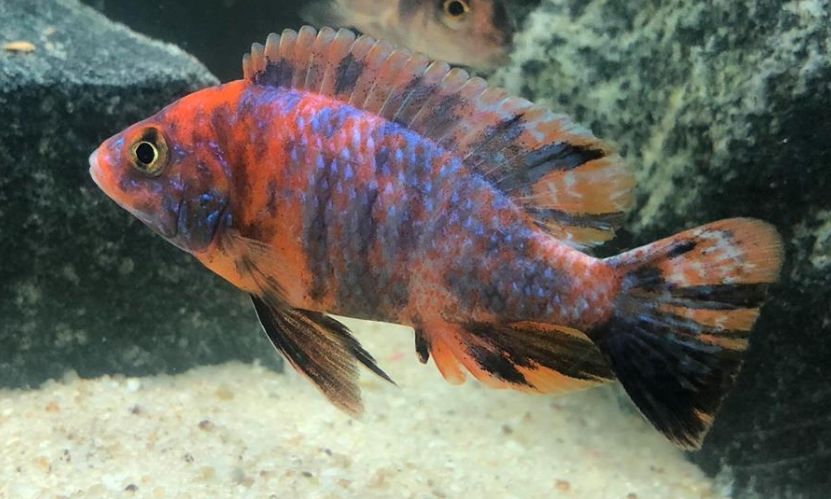
KH Terminology
KH terminology is confusing because different people use different terms for it, often incorrectly. Here are some of the terms used:
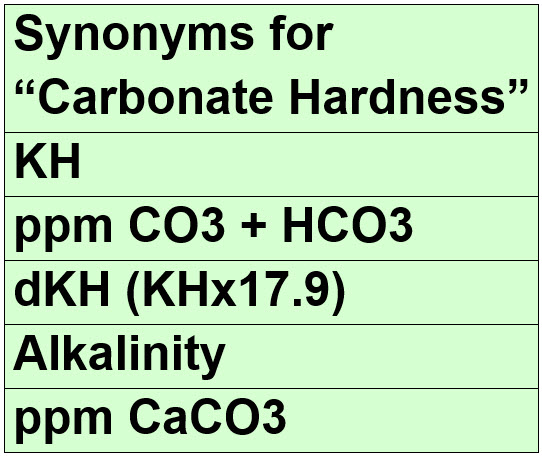

Further Analysis
The complex relationship between KH, CO2 and pH is, as we said above, the “Bermuda Triangle” of Fishkeeping. But if one really is a nerd like the author and really wants to understand it one has to do a LOT of reading. These articles all examine various aspects of this triangle.
CO2 and pH in the Aquarium
The complex relationship between CO2 and pH is explored in depth in this article:
4.4.3. Carbon Dioxide and pH
KH and Cycling
KH is important in intensive cycling of an aquarium. This topic is covered in this article:
4.5.2.1. KH and Cycling in an Aquarium
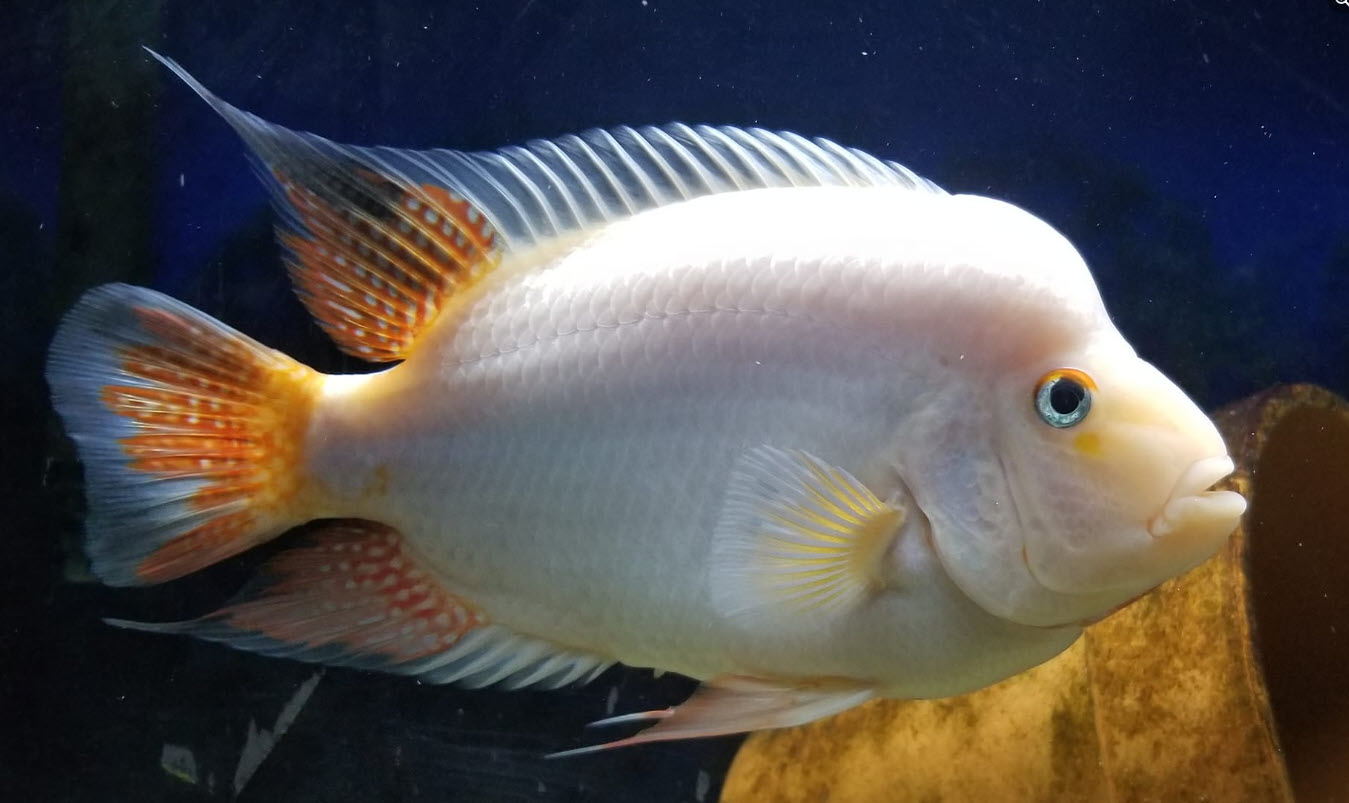
Planted Tanks and KH
If one wants to understand the relationship between carbon dioxide and KH in a planted tank these articles will be of some benefit:
15.6. Carbon Dioxide in the Planted Tank
15.6.2. CO2, KH and pH in the Planted Tank
GH or General Hardness
If one wants to look at the science behind the other type of hardness, namely GH or general hardness, go to this link:
4.5.1. General Hardness.

.
Return to Temperature, pH, KH and GH
.
Aquarium Science Website
The chapters shown below or on the right side in maroon lead to close to 400 articles on all aspects of keeping a freshwater aquarium. These articles have NO links to profit making sites and are thus unbiased in their recommendations, unlike all the for-profit sites you will find with Google. Bookmark and browse!
.

Dave says
In reply to Alex ….. It all has to do with loading and ammonia. If you are cycling a tank with a high loading of just ammonia then you need a source of carbon (i.e. KH). If you are running a tank with food as the ammonia source then the food and atmospheric carbon dioxide seem to be able to “keep up”. Obviously it will also be dependent on the natural KH of the water and water changes and stocking.
Alex says
Why is 0 kH only an issue during cycling? Doesn’t the tank still need bacteria to process ammonia and nitrite even after the cycling phase is over?